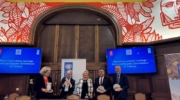Europa Nostra and Council of Europe Development Bank targets Amphitheatre in Durres
The Roman amphitheatre in Durrës, listed as one of The 7 Most Endangered Monuments and Sites in Europe, was visited by heritage and financial experts from Europa Nostra and the Council of Europe Development Bank (CEB), on 8-9 October. Dating back to the 2nd century AD, the monument was discovered only in the 1960s and it is still today partially-buried. The Albanian Government has undertaken several initiatives to study and recover the heritage site over the last decades. However, European technical expertise and financial support are needed to address its urgent, complex and costly rehabilitation. The delegates participated in meetings with high representatives from national and local entities, including the Minister of Culture, the Minister of Urban Development and Tourism and the Mayor of Durrës, to discuss the restoration and redevelopment strategies of this remarkable monument.

Located in the centre of Durrës, it is one of the largest and most important amphitheatres in the Balkan Peninsula and the only one of its kind in Albania, embodying unique architectural and cultural values. Due to its late discovery, the monument has endured chaotic urban planning, which has affected its structure, and suffered from continued deterioration. The Albanian Government has promoted some excavation work, topographical, archaeological and architectural studies and emergency consolidation and restoration work over the last decades, supported by other partners. In spite of that, the heritage site has reached a critical stage and is in urgent need of being rescued. European technical expertise and financial support are required to address the complex and costly rehabilitation of the amphiteatre.
On 8 October, after being welcomed at a reception by the Chairwoman of the Association for Development of Cultural Tourism, Armada Molla, who made the nomination for ‘The 7 Most Endangered’ programme, the delegation of Europa Nostra, represented by its Vice-president Irina Subotic and its Scientific Council Member Pedro Ponce de Léon, and the Council of Europe Development Bank, represented by Urbano Murillo, visited the Roman amphiteatre in Durrës and the surrounding monuments – the Byzantine Wall and Round Forum, the Public Roman Bath, the Basilica of Saint Michael and a villa with an Orpheus Mosaic – and attended a meeting with the Mayor of Durrës, Vangjush Dako. The successful integration of the monument into the urban fabric of Durrës dominated the agenda. The Mayor stressed the need for common efforts to study, preserve, restore and protect this heritage site. He also mentioned the interest of Prime Minister Edi Rama in the rehabilitation of the amphitheatre as part of the revitalisation strategy for the city centre.
On 9 October, the European delegation and its local partners participated in official meetings with the Minister of Culture, Mirela Kumbaro, the Minister of Urban Development and Tourism, Eglantina Gjermeni, and a representative of the Ministry of Youth and Social Welfare, Rubin Beqo, who reinforced the interest of the Government in the case and expressed their willingness to collaborate with the local and European bodies.
“The Roman amphiteatre is a major European monument. Its complete restoration would play a key role in the development of cultural tourism in Durrës, thus triggering the social and economic revitalisation of the city, and Albania in general. Its comprehensive rehabilitation would thus put the ancient city of Durrës back on the map of historic sites in Europe”, the Vice-president of Europa Nostra has stated on various occasions.
The delegates gathered with Albanian experts from the Institute of Archaeology, the Institute of Cultural Monuments and the Regional Directorate of National Culture to evaluate the current situation of the monument and discuss proposals for its future development.
“Never has the need for conservation, preservation and further excavation been so urgent”, stressed Professor Lida Miraj, Council Member of Europa Nostra, who has led a number of archaeological excavations in the amphitheatre and published several studies on it, and is calling for a prompt intervention.
“The site, which includes the Roman Amphitheatre, the Byzantine Wall, Venetian Towers and Ottoman Wall, should be approached as a cultural and heritage complex, and therefore has various problems which are difficult to solve”, said architect Pedro Ponce de Léon.
“The feasibility study, which will be prepared by international and national experts and funded by the CEB, through the Spanish Social Cohesion Account, shall show the main and most urgent interventions and a preliminary view of the size of the project as well as a cost estimate”, affirmed Urbano Murillo, Spanish Trust Fund Manager at the Council of Europe Development Bank, associated partner of ‘The 7 Most Endangered’ programme.
The results of the rescue mission to Durrës will be presented, together with the outcomes of the six other missions, at the European Heritage Policy Conference, organised by Europa Nostra, in Brussels on 5 December.






